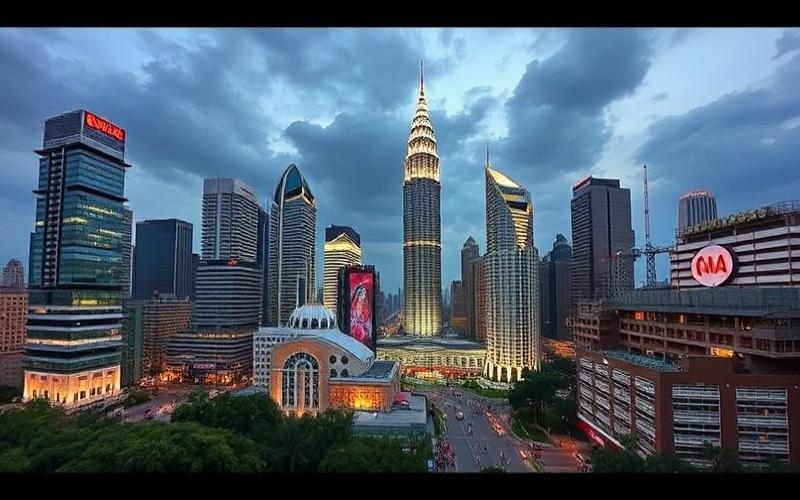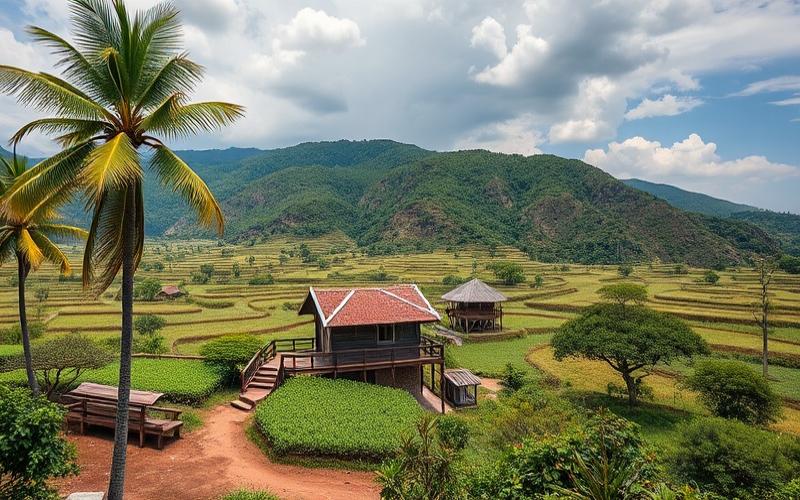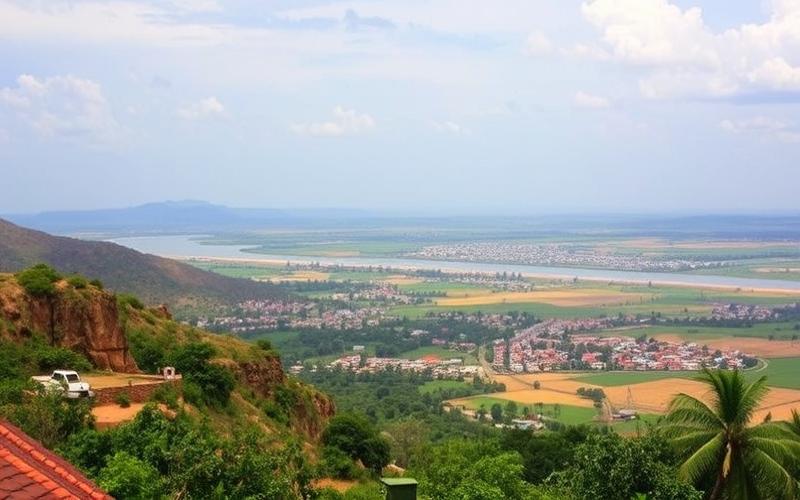
 Published on and written by Cyril Jarnias
Published on and written by Cyril Jarnias
Malaysia, with its dynamic economy and strategic position in Southeast Asia, is increasingly attracting the attention of international real estate investors. This multicultural country offers a unique blend of modernity and tradition, combined with a promising real estate market. In this article, we will explore the reasons why Malaysia has become a preferred destination for real estate investment, the opportunities it offers, and the practical aspects to consider for foreign investors.
Discover our other articles on real estate investment in Malaysia:


Malaysia, a rapidly developing Southeast Asian nation, is increasingly capturing the attention of international real estate investors. With its political [...]


Malaysia has become a preferred destination for many foreign real estate investors in recent years. With its dynamic economy, political [...]


Tourism has become a major economic driver for Malaysia, attracting millions of visitors each year. This growing influx of tourists [...]


Here is a comprehensive article about the real estate purchasing process for foreigners in Malaysia: Malaysia is an increasingly popular [...]


Malaysia, with its pristine sandy beaches, vibrant cities, and rich culture, has become a top destination for travelers worldwide. This [...]


Malaysia, a dynamic Southeast Asian nation, is experiencing vibrant urban growth. With a growing economy and a clear commitment to [...]


Malaysia, with its paradise beaches, rich culture, and dynamic economy, is attracting an increasing number of foreign real estate investors. [...]


Malaysia, with its dynamic economy and growing real estate market, is attracting more and more foreign investors. This Southeast Asian [...]


Here is a detailed article about common mistakes when purchasing real estate in Malaysia: Malaysia attracts many foreign investors thanks [...]


Malaysia, with its unique blend of modernity and traditions, has become a preferred destination for wealthy real estate investors worldwide. [...]


Malaysia has become a top destination for international real estate investors in recent years. With its dynamic economy, political stability, [...]


Malaysia has become a top destination for foreign real estate investors in recent years. With its dynamic economy, high quality [...]


Renovating a property in Malaysia can significantly increase its value in the local real estate market while allowing you to [...]


Malaysia is attracting more and more foreign real estate investors thanks to its dynamic market and attractive prices. However, selling [...]
A Promised Land for Real Estate Investors: Why Malaysia?
Malaysia presents numerous advantages that make it an attractive destination for international real estate investors. First, the country benefits from remarkable political and economic stability. Since its independence in 1957, Malaysia has experienced constant economic growth, with a GDP that increased by an average of 5.4% per year between 2010 and 2019. Despite the slowdown due to the COVID-19 pandemic, the Malaysian economy has shown impressive resilience and is expected to rebound strongly in the coming years.
Another key factor is the relatively low cost of living in Malaysia, particularly compared to other popular Asian destinations like Singapore or Hong Kong. This means investors can enjoy higher purchasing power and potentially obtain better returns on their real estate investments.
Furthermore, the Malaysian government has implemented policies favorable to foreign investors. The “Malaysia My Second Home” (MM2H) program allows foreigners to obtain a long-term residence visa, which facilitates property purchase and settling in the country. This policy, combined with relatively liberal property laws for foreigners, makes Malaysia particularly attractive to international investors.
Finally, Malaysia offers a high quality of life with modern infrastructure, a quality healthcare system, and a pleasant tropical climate year-round. These factors contribute to attracting not only investors but also expatriates and retirees, thus creating constant demand for quality properties.
Good to Know:
Malaysia offers a stable and favorable environment for foreign investors, with an affordable cost of living and high quality of life, making it a preferred destination for real estate investment in Southeast Asia.
The Malaysian Real Estate Market: Attractive Prices for All Budgets
The Malaysian real estate market is characterized by its diversity and accessibility. Property prices vary considerably depending on location, property type, and construction quality. However, compared to other developed Asian markets, prices in Malaysia generally remain more affordable.
In Kuala Lumpur, the capital, the average price for downtown apartments is around 6,000 to 8,000 Malaysian ringgits (RM) per square meter, or approximately 1,200 to 1,600 euros. In suburban areas, prices can drop to 4,000-5,000 RM/m² (800-1,000 euros/m²). These figures are significantly lower than those in Singapore or Hong Kong, where downtown prices can easily exceed 20,000 euros/m².
It’s important to note that the Malaysian real estate market has experienced a slight correction in recent years, partly due to oversupply in certain segments. This situation has created interesting opportunities for investors, with more competitive prices and long-term growth potential.
Example prices for different types of housing:
- Luxury apartment in downtown Kuala Lumpur (100m²): 600,000 – 800,000 RM (120,000 – 160,000 euros)
- Single-family home in a residential suburb (200m²): 800,000 – 1,200,000 RM (160,000 – 240,000 euros)
- Apartment in a secondary city like Penang (80m²): 300,000 – 500,000 RM (60,000 – 100,000 euros)
These prices remain indicative and may vary depending on numerous factors, including exact location, amenities, and property condition.
Good to Know:
Real estate prices in Malaysia are generally more affordable than in other major Asian cities, thus offering interesting opportunities for investors with varying budgets.
A Wide Range of Choices: Main Types of Housing in Malaysia
The Malaysian real estate market offers a wide variety of housing types to meet different investor needs and preferences. Here’s an overview of the main available options:
1. Condominiums and Apartments
Condominiums are very popular in Malaysia, particularly in urban areas like Kuala Lumpur and Penang. These residential complexes typically offer a range of amenities such as swimming pools, gyms, and green spaces. Prices vary considerably depending on location and offered services.
Price Example: A 2-bedroom apartment in a luxury condominium in Mont Kiara, a sought-after neighborhood in Kuala Lumpur, can cost between 800,000 and 1,200,000 RM (160,000 – 240,000 euros).
2. Single-Family Homes (Landed Properties)
Single-family homes, called “landed properties” in Malaysia, are highly sought after, particularly by families. They include terrace houses, semi-detached houses, and bungalows.
Price Example: A 3-bedroom terrace house in a residential suburb of Kuala Lumpur like Petaling Jaya can cost between 600,000 and 1,000,000 RM (120,000 – 200,000 euros).
3. Serviced Apartments
Serviced apartments are a hybrid category between classic apartments and hotels. They offer hotel services while allowing long-term residence. This property type is particularly popular with expatriates and investors seeking short-term rental properties.
Price Example: A one-bedroom serviced apartment in downtown Kuala Lumpur can cost between 500,000 and 800,000 RM (100,000 – 160,000 euros).
4. Luxury Villas
For high-end investors, Malaysia also offers luxury villas, often located in exclusive complexes or sought-after coastal areas.
Price Example: A luxury villa with sea view in Langkawi can reach 3,000,000 RM (600,000 euros) or more.
5. Commercial Properties
Although less common for individual investors, commercial properties like offices, retail spaces, and warehouses can offer interesting opportunities for portfolio diversification.
It’s important to note that each property type has its own advantages and disadvantages in terms of investment. Condominiums and serviced apartments, for example, can offer higher rental yields and easier management, while single-family homes can offer better long-term appreciation potential.
Good to Know:
Malaysia offers a wide variety of housing types, from modern apartments to traditional houses, including luxury properties. This diversity allows investors to find opportunities suited to their objectives and budget.
Golden Zones: The Most Attractive Regions for Real Estate Investment in Malaysia
Malaysia offers numerous real estate investment opportunities throughout the country, but some regions particularly stand out for their growth potential and appeal to international investors. Here’s an overview of the most promising areas:
1. Kuala Lumpur and the Klang Valley
The capital and its metropolitan region remain the economic heart of Malaysia and naturally attract many investors. The most sought-after neighborhoods include:
– KLCC (Kuala Lumpur City Centre): Downtown offers luxury properties with spectacular views of the Petronas Towers. – Mont Kiara: A high-end residential neighborhood popular with expatriates. – Bangsar: A trendy neighborhood offering a mix of residential and commercial properties. – Petaling Jaya: A booming satellite city offering a good balance between affordable prices and quality of life.
2. Penang
Nicknamed the “Pearl of the Orient,” Penang is an island in northwestern Malaysia that is attracting more and more investors. Its historic center, George Town, is a UNESCO World Heritage Site. The most attractive areas include:
– Gurney Drive: A prestigious waterfront with luxury condominiums. – Tanjung Bungah and Batu Ferringhi: Popular coastal areas for vacation properties. – Bayan Lepas: A growing technology hub offering investment opportunities in residential and commercial real estate.
3. Johor Bahru
Located on the border with Singapore, Johor Bahru benefits from its proximity to the city-state. The massive development of Iskandar Malaysia has created numerous investment opportunities. Areas to watch include:
– Nusajaya: A planned new town with ambitious development projects. – Danga Bay: A developing waterfront offering residential and commercial properties.
4. Kota Kinabalu, Sabah
The capital of Sabah state, on the island of Borneo, is attracting increasing attention from investors due to its tourism potential and economic development. Areas of interest include:
– Kota Kinabalu city center: Offering sea views and easy access to urban amenities. – Likas Bay: A developing coastal area with high-end residential projects.
5. Melaka
This historic city, also a UNESCO World Heritage Site, is experiencing renewed interest from investors. Opportunities are mainly found in:
– The historic center: Offering possibilities for renovating old properties. – Klebang: A developing coastal area with new residential projects.
Each of these regions has its own advantages and challenges. For example, Kuala Lumpur offers a more mature and liquid market but with higher prices, while cities like Kota Kinabalu may offer better long-term growth potential but with a less developed market.
It’s crucial for investors to understand local dynamics, development trends, and specific regulations for each region before making an investment decision.
Good to Know:
Although Kuala Lumpur remains the main investment center, other regions like Penang, Johor Bahru, and Kota Kinabalu offer interesting opportunities with varying risk and return profiles. A geographic diversification strategy can be wise for investors seeking to optimize their real estate portfolio in Malaysia.
Malaysia vs. Its Competitors: Comparison with Other Investment Destinations in Southeast Asia
To better understand Malaysia’s appeal as a real estate investment destination, it’s useful to compare it with other popular countries in the region. Here’s a comparative analysis with some key destinations:
1. Malaysia vs. Singapore
Singapore is often considered the financial center of Southeast Asia, but its real estate prices are among the highest in the world.
- Prices: Properties in Singapore are on average 3 to 4 times more expensive than in Malaysia.
- Rental Yield: Yields in Singapore are generally lower (2-3%) than in Malaysia (4-6%).
- Restrictions: Singapore imposes stricter restrictions on property purchases by foreigners.
- Stability: Both countries offer political and economic stability, but Singapore is perceived as slightly more stable.
Malaysia Advantage: Better value for money and potentially higher returns.
2. Malaysia vs. Thailand
Thailand is a popular destination for real estate investment, particularly in tourist areas.
- Prices: Prices in Thailand are generally comparable to those in Malaysia, or even slightly lower in some regions.
- Restrictions: Thailand has more restrictive laws on foreign ownership, often limiting foreigners to long-term leases or condominium ownership.
- Market: The Thai market is more tourism-oriented, while Malaysia offers a more balanced mix between residential and commercial.
- Stability: Malaysia is generally perceived as more politically and economically stable.
Malaysia Advantage: More favorable property laws for foreigners and more diversified economy.
3. Malaysia vs. Vietnam
Vietnam is an emerging market that is attracting increasing attention from investors.
- Prices: Properties in Vietnam can be cheaper than in Malaysia, particularly in developing areas.
- Growth: Vietnam shows higher economic growth rates, which could translate to faster property appreciation.
- Risk: The Vietnamese market is considered more volatile and less mature than Malaysia’s.
- Infrastructure: Malaysia has more developed infrastructure and a more favorable business environment.
Malaysia Advantage: More mature and stable market, better infrastructure.
4. Malaysia vs. Indonesia
Indonesia, particularly Bali, is a popular destination for real estate investment.
- Prices: Prices in Indonesia can be lower than in Malaysia, but vary considerably by region.
- Restrictions: Indonesia has more restrictive laws on foreign ownership, making investment more complex.
- Market: The Indonesian market is more fragmented and less transparent than Malaysia’s.
- Stability: Malaysia generally offers a more stable and predictable environment for investors.
Malaysia Advantage: Clearer legal framework and more transparent real estate market.
In summary, Malaysia positions itself as a balanced option among its regional competitors. It offers a good compromise between stability, potential return, and ease of investment for foreigners. While other countries may offer specific opportunities (like lower prices in Vietnam or a strong tourism market in Thailand), Malaysia stands out for its overall environment favorable to foreign investors.
Good to Know:
Malaysia offers an attractive balance between stability, potential return, and ease of investment for foreigners, positioning itself advantageously compared to its Southeast Asian neighbors. However, each market has its own characteristics, and investors must carefully assess their objectives and risk tolerance before making a decision.
Practical Guide: How Can a Foreigner Acquire Property in Malaysia?
Malaysia is one of the most open countries in Southeast Asia to foreign real estate investors. However, there are certain specific rules and procedures to follow. Here’s a step-by-step guide for foreigners wishing to acquire property in Malaysia:
1. Understand the Restrictions
Although foreigners can buy properties in Malaysia, there are a few restrictions:
– Foreigners generally cannot buy properties classified as “Bumiputera,” reserved for ethnic Malays and indigenous people. – There is a minimum price for foreign purchases, which varies by state. For example, in Kuala Lumpur, the minimum price is 1 million RM (approximately 200,000 euros). – Certain property types, like low-cost housing and agricultural properties, are generally prohibited to foreigners.
2. Choose the Right Property Type
The property types most commonly purchased by foreigners include:
– Condominiums and apartments – Single-family homes (subject to local restrictions) – Commercial properties
3. Obtain State Government Approval
Property purchase by a foreigner generally requires approval from the relevant state government. This procedure can take 1 to 3 months.
4. Financing
Foreigners can obtain mortgage loans from Malaysian banks, but conditions are generally stricter:
– The loan-to-value ratio is often limited to 70% for foreigners. – Interest rates may be slightly higher. – Proof of stable income and good credit score are essential.
5. Purchase Process
- Make an offer and sign a reservation agreement.
- Sign the sale and purchase agreement.
- Pay a deposit (generally 10% of the purchase price).
- Obtain state government approval.
- Finalize financing if necessary.
- Complete property transfer and pay the balance.
6. Additional Costs
Additional costs should be anticipated, including:
– Legal fees (approximately 1% of purchase price) – Stamp duty (1-3% of purchase price) – Valuation and surveying fees – State approval application fees
7. Tax Considerations
Foreign owners are subject to real property gains tax upon sale. The rate varies depending on the property holding period.
8. Malaysia My Second Home (MM2H) Program
This program offers a long-term residence visa and can facilitate property purchase. Conditions include:
– A fixed bank deposit of at least 1 million RM (approximately 200,000 euros) – Proof of monthly offshore income of at least 40,000 RM (approximately 8,000 euros)
It is highly recommended to work with a local lawyer specialized in real estate law and a licensed real estate agent to navigate this process. They can help you understand the nuances of local laws and avoid potential pitfalls.
Good to Know:
Although Malaysia is relatively open to foreign investors, the purchase process involves several steps and approvals. It’s crucial to research local regulations thoroughly and work with competent professionals to successfully complete your real estate investment project.
Rental Yield in Malaysia: Attractive Returns for Savvy Investors
One of the most attractive aspects of real estate investment in Malaysia is the potential for rental profitability. Although yields vary depending on many factors, such as location, property type, and management quality, Malaysia generally offers competitive rental yields compared to other developed Asian markets.
Average Rental Yields
Generally, gross rental yields in Malaysia range between 4% and 8% per year, with significant variations by region and property types:
– Kuala Lumpur: 4-6% for residential properties – Penang: 4-7% for well-located apartments – Johor Bahru: 5-8% for properties near Singapore – Kota Kinabalu: 6-8% for well-managed tourist properties
Concrete Example of Rental Profitability
Let’s take the example of an investment in a two-bedroom apartment in Mont Kiara, a sought-after neighborhood in Kuala Lumpur:
– Purchase price: 800,000 RM (approximately 160,000 euros) – Monthly rent: 3,500 RM (approximately 700 euros) – Annual rental income: 42,000 RM (approximately 8,400 euros) – Gross rental yield: 5.25% per year
Note that this yield is gross and does not account for expenses such as management fees, maintenance, taxes, and vacancy periods.
Factors Influencing Profitability
- Location: Properties in central areas or with high rental demand (like near universities or business districts) tend to offer better yields.
- Property Type: Small apartments and studios often have higher yields than large properties.
- Management Quality: Effective management can maximize occupancy rates and rental income.
- Target Market: Targeting expatriates or international students can enable higher rents.
- Seasonality: In tourist areas, short-term rentals can offer higher yields but with more volatility.
Strategies to Maximize Profitability
1. Look for properties in developing areas but with good growth potential. 2. Invest in targeted renovations to increase appeal and justify higher rents. 3. Consider furnished rentals, particularly attractive to expatriates. 4. Explore short-term rental opportunities in popular tourist areas. 5. Work with a professional rental management agency to optimize occupancy rates and income.
Tax Considerations
Rental income in Malaysia is subject to income tax. Rates range from 0% to 30% depending on income amount. Owners can deduct certain expenses, such as maintenance and mortgage interest, from their taxable income.
It’s important to note that while these yields may seem attractive, they come with risks and responsibilities. Investors must consider market fluctuations, changes in local regulations, and long-term maintenance costs.
Good to Know:
Malaysia offers attractive rental yields, often higher than those in mature real estate markets like Singapore or Hong Kong. However, thorough analysis of the local market and effective management are essential to maximize the profitability of your real estate investment.
In conclusion, real estate investment in Malaysia presents numerous advantages for international investors. With its attractive rental yields, growing market, and regulatory framework relatively favorable to foreigners, Malaysia stands out as a preferred destination for diversifying a real estate portfolio in Southeast Asia.
However, as with any international investment, it’s crucial to thoroughly understand the specifics of the local market, current regulations, and potential risks. Thorough due diligence and the use of experienced local professionals are essential to succeed in your real estate investment in Malaysia.
Disclaimer: The information provided on this website is for informational purposes only and does not constitute financial, legal, or professional advice. We encourage you to consult qualified experts before making any investment, real estate, or expatriation decisions. Although we strive to maintain up-to-date and accurate information, we do not guarantee the completeness, accuracy, or timeliness of the proposed content. As investment and expatriation involve risks, we disclaim any liability for potential losses or damages arising from the use of this site. Your use of this site confirms your acceptance of these terms and your understanding of the associated risks.



